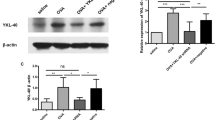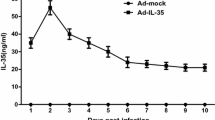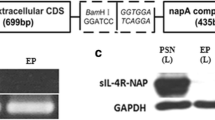Abstract
Bone marrow eosinophilopoiesis induced by interleukin (IL)-5 is a major contributor to eosinophilic airway inflammation in asthma. However, research on the use of IL-5 receptor alpha (IL-5Rα) as the target has seldom been reported. This study was undertaken to explore the effects of inhibition of IL-5Rα expression through an IL-5Rα short hairpin RNA-expressing vector on bone marrow eosinophilopoiesis and airway inflammation in an asthmatic mouse model. An effective plasmid vector was selected that could express short hairpin RNA targeted at IL-5Rα (P-IL-5Rα). An adenovirus vector (Ad) was then constructed that was inserted in an effective template sequence (Ad-IL-5Rα). An animal model of asthma was established by sensitizing and challenging Balb/c mice with ovalbumin. Animals were treated intravenously with Ad-IL-5Rα and changes in bone marrow eosinophilopoiesis and airway inflammation were detected in asthmatic mice. Investigators found that P-IL-5Rα-3 targeted at the sequence of CAG CTG CCT GGT TCG TCT T markedly suppressed IL-5Rα expression in B lymphoma cells in vitro. In addition, Ad-IL-5Rα could suppress IL-5Rα expression in murine bone marrow cells in vitro and in vivo, and it could significantly decrease IL-5-induced eosinophilia in cultured bone marrow cells. Additional studies indicated that intravenously injected Ad-IL-5Rα not only selectively reduced the number of eosinophils in the bone marrow, peripheral blood, and bronchoalveolar lavage fluid, it also relieved airway inflammation in asthmatic mice. Results reported here show that blocking of IL-5Rα expression through RNA interference can enhance effective treatment of asthma, and that bone marrow can be used as a key targeted organ in the treatment of asthmatic mice.
Similar content being viewed by others
References
Sampson AP. The role of eosinophils and neutrophils in inflammation.Clin Exp Allergy. 2000; 30(suppl 1): 22–27.
Tobin MJ. Asthma, airway biology, and allergic rhinitis in AJRCCM 2000.Am J Respir Crit Care Med. 2001; 164: 1559–1580.
Ohkawara Y, Lei XF, Stampfli MR, et al. Cytokine and eosinophil responses in the lung, peripheral blood, and bone marrow compartments in a murine model of allergen-induced airways inflammation.Am J Respir Cell Mol Biol. 1997; 16: 510–520.
Brock TG, Anderson JA, Fries FP, et al. Decreased leukotriene C4 synthesis accompanies adherence-dependent nuclear import of 5-lipoxygenase in human blood eosinophils.J Immunol. 1999; 162: 1669–1676.
Oosaki R, Mizushima Y, Kawasaki A, et al. Correlation among urinary eosinophil protein X, leukotriene E4, and 11-dehydrothromboxane B2 in patients with spontaneous asthmatic attack.Clin Exp Allergy. 1998; 28: 1138–1144.
Gauvreau GM, Wood LJ, Sehmi R, et al. The effect of inhaled budesonide on circulating eosinophil progenitors and their expression of cytokines after allergen challenge in subjects with atopic asthma.Am J Respir Crit Care Med. 2000; 162: 2139–2144.
Sitkauskiene B, Radinger M, Bossios A, et al. Airway allergen exposure stimulates bone marrow eosinophilia partly via IL-9.Respir Res. 2005; 6: 33.
Martinez-Moczygemba M, Huston DP. Biology of common beta receptor-signaling cytokines: IL-3, IL-5, and GM-CSF.J Allergy Clin Immunol. 2003; 112: 653–665.
Saito H, Matsumoto K, Denburg AE, et al. Pathogenesis of murine experimental allergic rhinitis: a study of local and systemic consequences of IL-5 deficiency.J Immunol. 2002; 168: 3017–3023.
Kung TT, Stelts DM, Zurcher JA, et al. Involvement of IL-5 in a murine model of allergic pulmonary inflammation: prophylactic and therapeutic effects of an anti-IL-5 antibody.Am J Respir Cell Mol Biol. 1995; 13: 360–365.
Yoshida T, Ikuta K, Sugaya H, et al. Defective B-1 cell development and impaired immunity againstAngiostrongylus cantonensis in IL-5R-alpha-deficient mice.Immunity. 1996; 4: 483–494.
Hart TK, Cook RM, Zia-Amirhosseini P, et al. Preclinical efficacy and safety of mepolizumab (SB-240563), a humanized monoclonal antibody to IL-5, in cynomolgus monkeys.J Allergy Clin Immunol. 2001; 108: 250–257.
Paddison PJ, Silva JM, Conklin DS, et al. A resource for large-scale RNA-interference-based screens in mammals.Nature. 2004; 428: 427–431.
Kurreck J. Antisense technologies: improvement through novel chemical modifications.Eur J Biochem. 2003; 270: 1628–1644.
Paddison PJ, Caudy AA, Sachidanandam R, et al. Short hairpin activated gene silencing in mammalian cells.Methods Mol Biol. 2004; 265: 85–100.
Sledz CA, Williams BR. RNA interference and double-stranded-RNA-activated pathways.Biochem Soc Trans. 2004; 32: 952–956.
Kawasaki H, Taira K. Short hairpin type of dsRNAs that are controlled by tRNA(Val) promoter significantly induce RNAi-mediated gene silencing in the cytoplasm of human cells.Nucleic Acids Res. 2003; 31: 700–707.
Brummelkamp TR, Bernards R, Agami R. A system for stable expression of short interfering RNAs in mammalian cells.Science. 2002; 296: 550–553.
Hacker DL, Bertschinger M, Baldi L, et al. Reduction of adenovirus E1 A mRNA by RNAi results in enhanced recombinant protein expression in transiently transfected HEK293 cells.Gene. 2004; 341: 227–234.
Cao HB, Wang A, Martin B, et al. Down-regulation of IL-8 expression in human airway epithelial cells through helper-dependent adenoviral-mediated RNA interference.Cell Res. 2005; 15: 111–119.
Gurzov EN, Izquierdo M. RNA interference against Hec1 inhibits tumor growth in vivo.Gene Ther. 2006; 13: 1–7.
Fulkerson PC, Zimmermann N, Hassman LM, et al. Pulmonary chemokine expression is coordinately regulated by STAT1, STAT6, and IFN-gamma.J Immunol. 2004; 173: 7565–7574.
Tomaki M, Zhao LL, Lundahl J, et al. Eosinophilopoiesis in a murine model of allergic airway eosinophilia: involvement of bone marrow IL-5 and IL-5 receptor alpha.J Immunol. 2000; 165: 4040–4050.
Sitkauskiene B, Johansson AK, Sergejeva S, et al. Regulation of bone marrow and airway CD34+ eosinophils by interleukin-5.Am J Respir Cell Mol Biol. 2004; 30: 367–378.
Hamid Q, Barkans J, Meng Q, et al. Human eosinophils synthesize and secrete interleukin-6, in vitro.Blood. 1992; 80: 1496–1501.
Heinonen JE, Smith CI, Nore BF. Silencing of Bruton’s tyrosine kinase (Btk) using short interfering RNA duplexes (siRNA).FEBS Lett. 2002; 527: 274–278.
Dorman SC, Efthimiadis A, Babirad I, et al. Sputum CD34+IL-5Ralpha+ cells increase after allergen: evidence for in situ eosinophilopoiesis.Am J Respir Crit Care Med. 2004; 169: 573–577.
Southam DS, Widmer N, Ellis R, et al. Increased eosinophil-lineage committed progenitors in the lung of allergen-challenged mice.J Allergy Clin Immunol. 2005; 115: 95–102.
Stirling RG, van Rensen EL, Barnes PJ, et al. Interleukin-5 induces CD34(+) eosinophil progenitor mobilization and eosinophil CCR3 expression in asthma.Am J Respir Crit Care Med. 2001; 164: 1403–1409.
Mao H, Wang ZL, Li FY, et al. Relationship between bone marrow-derived CD34+ cells expressing interleukin-5 receptor messenger RNA and asthmatic airway inflammation.Chin Med J. 2004; 117: 24–29.
Mao H, Yin KS, Wang ZL, et al. Effects of glucocorticoid and cysteinyl leukotriene 1 receptor antagonist on CD(34+) hematopoietic cells in bone marrow of asthmatic mice.Chin Med J. 2004; 117: 592–597.
Tahvanainen J, Pykalainen M, Kallonen T, et al. Enrichment of nucleofected primary human CD4+ T cells: a novel and efficient method for studying gene function and role in human primary T helper cell differentiation.J Immunol Methods. 2006; 310: 30–39.
Li M, Rossi JJ. Lentiviral vector delivery of siRNA and shRNA encoding genes into cultured and primary hematopoietic cells.Methods Mol Biol. 2005; 309: 261–272.
Ito T, Hashimoto Y, Tanaka E, et al. An inducible short-hairpin RNA vector against osteopontin reduces metastatic potential of human esophageal squamous cell carcinoma in vitro and in vivo.Clin Cancer Res. 2006; 12: 1308–1316.
Gonzalez-Santos JM, Cao H, Wang A, et al. A complementation method for functional analysis of mammalian genes.Nucleic Acids Res. 2005; 33: e94.
Lach-Trifilieff E, McKay RA, Monia BP, et al. In vitro and in vivo inhibition of interleukin (IL)-5-mediated eosinopoiesis by murine IL-5Ralpha antisense oligonucleotide.Am J Respir Cell Mol Biol. 2001; 24: 116–122.
Author information
Authors and Affiliations
Rights and permissions
About this article
Cite this article
Mao, H., Wen, FQ., Liu, CT. et al. Effect of interleukin-5 receptor-α short hairpin RNA-expressing vector on bone marrow eosinophilopoiesis in asthmatic mice. Adv Therapy 23, 938–956 (2006). https://doi.org/10.1007/BF02850216
Issue Date:
DOI: https://doi.org/10.1007/BF02850216




